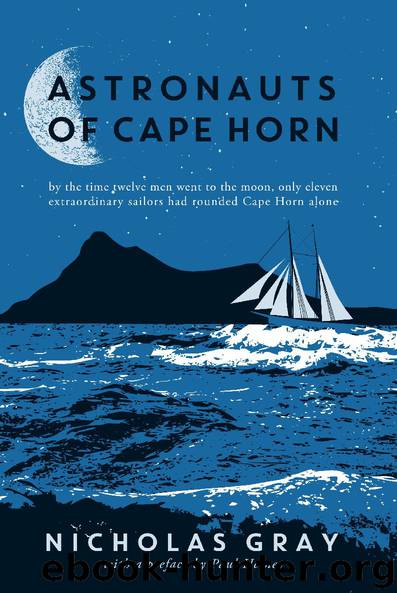Astronauts of Cape Horn by Nicholas Gray

Author:Nicholas Gray
Language: eng
Format: epub
Tags: Astronauts of Cape Horn: solo sailing;round the world;sea;Cape Horn;danger;astronauts;moon landings
Publisher: The Conrad Press
Published: 2018-09-15T00:00:00+00:00
Chapter 11 Francis Chichester – The largest boat
The days of the lonely romantic voyager, sailing the seas simply for his or her own satisfaction, alone, self sufficient, asking nothing of anyone else, quietly departing and quietly arriving, were nearly over. Allcard and the others before him asked nothing more than to be left alone to plough their lonely furrows across the world’s oceans, disturbing no-one and leaving no trace once they had moved on.
By 1966, with only a few exceptions, the age of what I might term ‘the commercial voyager’ had arrived where ocean voyages were primarily made for gain, for publicity and for the record books. To achieve this, money was needed, lots of it and sponsors were avidly sought. Special purpose boats were built, book and film contracts were drawn up, publicity merchants were engaged and newspapers were signed up to report on the participants’ derring-does. Navies were asked to look out for and shepherd these intrepid voyagers round dangerous headlands. Boats were laden with liferafts, safety equipment and ship-to-shore radios or satellite phones, to ensure that these brave yachtsmen could call on aircraft, lifeboats and other rescue services around the world to rescue them when they got into difficulty.
The days when a lone sailor crossing an ocean would be totally self reliant, never expecting to be rescued and to ‘die like a gentleman’ were now over. Such a philosophy was well expounded by Blondie Hasler (of Cockleshell Heroes fame) to whom this expression is attributed and who founded the series of Observer Single-Handed Transatlantic Races. He said a competitor in such a race should sail it at his own risk and nobody else’s, adding ‘I would be happy to accept the fact that I should drown if I couldn’t solve my own problems. I dread the idea of ships having to conduct rescue operations.’ This was very much the sentiment Allcard and his like propounded. Not however this new breed of voyagers.
Whilst the advent of money and commercialisation had begun to creep into some sailing in the early 1960s, it was Francis Chichester, the next Cape Horn astronaut to go, who first commercialised long distance solo sailing. His boat was paid for by a third party and was emblazoned with a sponsors logo (the Woolmark sign). He signed a book deal, engaged a publicist and sent regular radio reports to a weekly newspaper. He was escorted round Cape Horn by a Royal Navy vessel whilst being photographed from above by an aeroplane chartered by the Sunday Times. On arrival back in Plymouth he was greeted by a huge flotilla of little ships and by a vast crowd on Plymouth Hoe. He was knighted by the Queen.
Sir Francis Chichester’s round the world voyage, taking in Cape Horn as he went, in the much maligned yacht Gipsy Moth IV is probably the best known, most read and written about and best documented of any voyage under sail since sailors took to the sea.
Download
This site does not store any files on its server. We only index and link to content provided by other sites. Please contact the content providers to delete copyright contents if any and email us, we'll remove relevant links or contents immediately.
The River by Peter Heller(2258)
Breath by James Nestor;(2231)
Sea Survival Handbook by Keith Colwell(2199)
Fatal Storm by Rob Mundle(2174)
Deep by James Nestor(2141)
Lonely Planet Australia by Lonely Planet(2034)
Iced In by Chris Turney(1959)
Discover Australia by Lonely Planet(1906)
Lonely Planet Maldives (Travel Guide) by Planet Lonely & Masters Tom(1800)
One Girl One Dream by Dekker Laura(1639)
Looking for a Ship by John McPhee(1630)
Chicken Soup for the Ocean Lover's Soul by Jack Canfield(1603)
Ten Degrees of Reckoning: The True Story of a Family's Love and the Will to Survive by Hester Rumberg(1601)
Lonely Planet Australia (Travel Guide) by Lonely Planet & Lonely Planet(1553)
South with the Sun by Lynne Cox(1542)
The Wave In Pursuit of the Rogues, Freaks and Giants of the Ocean(1505)
Diver Down by Michael Ange(1471)
Marlinspike Sailor's Arts and Crafts by Barbara Merry(1455)
The Golden Rules: 10 Steps to World-Class Excellence in Your Life and Work by Bob Bowman & Charles Butler(1429)
